- Home
- J. T. Edson
Under the Stars and Bars
Under the Stars and Bars Read online
UNDER THE STARS
AND BARS
JT
EDSON
UNDER THE STARS AND BARS
‘Cursed be all traitors!’ Parson Wightman bellowed, reaching for his gun; an example followed by his three companions.
Starting at the same instant, Dusty and the scout commenced their draw. Flashing across, Dusty’s hands curled around the bone handles of his Army Colts. Turning palms outwards, the scout wrapped his fingers about the ivory grips of his matched Navies. The .44 calibre revolvers cleared Dusty’s holsters slightly ahead of the .36 handguns leaving the long-haired scout’s silk sash. Swinging into alignment at waist level, Dusty’s weapons made a single crash; to be echoed by the lighter, more ragged twin bark of his companion’s armament.
Hit twice in the head, Wightman fell with his Navy Colt still not clear of leather. Caught in the withering blast of gunfire, the man to his right and left sides joined him in crashing to the ground.
UNDER THE STARS AND BARS
A CORG1 BOOK 552 08589 8
First publication in Great Britain
PRINTING HISTORY
Corgi edition published 1970
Corgi edition reprinted 1974
Corgi edition reprinted 1979
Copyright © 1970 by J. T. Edson
This book is set in Pilgrim 10/10½ pt.
Corgi Books are published by Transworld Publishers, Ltd.,
Century House, 65—63 Uxbridge Road, Ealing, London, W5 5SA
Made and printed in Great Britain by
Richard Clay (The Chaucer Press), Ltd., Bungay, Suffolk.
The sudden drumming of hooves mingling with the crackle of revolvers’ shots, accompanied by a ringing shout of ‘Yeeah! Texas Light!’. Following them, smoke and flames might rise from a Quartermasters’ Corps depot; a supply train would be found, its wagons wrecked, their loads carried off and teams driven away; a cursing Artillery officer could find the guns in his battery spiked and his magazine exploded.
That was how the men who rode under the Stars and Bars flag of the Confederate States fought against the Yankees in Arkansas. One name ranked high when such incidents were mentioned. That of an eighteen year old captain, the commanding officer of the Texas Light Cavalry’s Company ‘C’.
His name was Dusty Fog.
For William R. Hicks of Portsmouth, Hants,
Who lets his dad read my books.
UNDER THE STARS
AND BARS
PART ONE
THE SCOUT
‘Here they come now, Captain Fog,’ whispered Logan Huntspill, head of the Confederate States’ spy-ring which operated out of Pine Bluff and maintained a watch over the activities of the Union’s Army of Arkansas along the Arkansas River south of that town. ‘What do you reckon to them?’
Keeping his field-glasses to his eyes, Captain Dustine Edward Marsden Fog turned his attention from the original objects of his scrutiny. Big, piggish of face, his almost bloated fat body straining the gold-lace-trimmed blue uniform’s seams, General Buller stood with several of his senior officers on top of a small knoll about half a mile from the two Rebels’ position. The Yankees were looking or pointing across the Akansas River to where a small, derelict steamboat bobbed at its moorings by the eastern bank. Beyond the old side-wheeler sat a cluster of dilapidated log cabins. Neither the boat nor the buildings seemed to merit the attention lavished on them by Buller’s party.
A sense of expectancy bit into Dusty as he turned his glasses in the direction indicated by his companion. At least he was going to see the reason for his being given orders at Prescott to ride as fast as possible to Pine Bluff and contact Huntspill.
Focussing the glasses on the new subject, Dusty felt both puzzled and a sense of anti-climax. The tall, thickset, bearded man sharing the concealment of the large clump of buffalo-berry bushes with him had hinted that something of great importance was due to happen. According to Huntspill’s message, brought by a courier to General Jackson Baines Hardin’s headquarters at Prescott, the Yankees were shortly to receive some new form of weapon that might once again put them on the offensive in the Toothpick State.
According to Ole Devil Hardin, Huntspill had always been accurate with his news and was no alarmist. The spy had stressed the extreme urgency of the matter and requested that an officer be sent to help him assess the extent of the danger. That had been sufficient to cause the commanding general of the Confederate States’ Army of Arkansas and North Texas to respond immediately. So Dusty was expecting to be confronted by a sight of more apparent importance than met his gaze. Especially after crossing the Ouachita River—the boundary separating the two opposing armies—and riding nearly sixty miles through enemy-held territory in just over twenty-four hours.
Going by his tone and expression, Huntspill felt doubts as to whether the officer sent by Ole Devil would have an opinion worth hearing. Of course, he remembered how Dusty Fog had been promoted to captain in the field after his superior officer had been killed and he had led Company ‘C’ of the Texas Light Cavalry in the charge that had turned the course of the battle at Mark’s Mill to the South’s favour. In meetings with other members of that regiment, Huntspill had heard his companion’s name mentioned several times; but he had formed an entirely different impression of what Captain Fog would be like.
The Texans had told of Dusty’s lighting fast withdrawal of his two revolvers and superlative accuracy when shooting from either hand. Never modest about the prowess of their State’s favourite sons, the beef-heads had claimed that Dusty Fog was the equal of Turner Ashby or even the Grey Ghost, John Singleton Mosby, as a military raider. A further boast—clearly false, even if the other two be true—was that Dusty possessed the bare-hand fighting knowledge to let him lick any man on the Confederate or Union side of the civil conflict.
Captain Fog had proved to be something of a disappointment to Huntspill. A young eighteen, he had a handsome, though not strikingly so, face with intelligence in its lines and grey eyes that looked at a man steadily. In height he would stand no more than five foot six inches; but with the wide shoulders and lean waist that hinted at considerable strength. A regulation white Jefferson Davis campaign hat was thrust back on his curly, dusty-blond hair. In the front centre of its crown rode a badge formed of a five-pointed star, with the letters TLC on it, in a laurel-wreath decorated circle. Based on the Lone Star State’s coat-of-arms, that was the insignia of the Texas Light Cavalry.
Possibly being Old Devil Hardin’s favourite nephew gave Dusty certain privileges. Certainly he flouted the Confederate States’ Army’s Manual of Dress Regulations on several points in his uniform.
The boots and tight-legged, yellow-striped riding breeches conformed with Regulations. Although his cadet-grey tunic had two rows of seven buttons on its double-breast, and a stand-up collar bearing the triple three-inch-long, half-inch-wide gold bars—the highest still looking newer than its mates—denoting his rank, it lacked the prescribed ‘skirt extending halfway between hip and knee’. True its sleeves carried the decorative double-strand gold-braid Austrian knot ‘chicken guts’, as a further aid to marking him as a captain, above their cavalry-yellow cuffs. However, the required black silk cravat was replaced by a tight-rolled scarlet bandana of the same material, long ends trailing down the front of his tunic.
About his lean waist was suspended a definitely non-issue gunbelt which possessed no means of carrying a sabre. Instead it had two holsters carefully designed so as to permit him to draw the matched bone-handled 1860 Army Colts with the minimum of effort and in the shortest possible time. The long-barrelled revolvers’ butts pointed forwards, but seemed to be angled differently than the conventional Army mode of carriage. Like many of the Texans
Huntspill had met, Dusty tied the tips of his holsters down with pigging thongs knotted around his thighs.
While the small captain looked neat, despite the long, hard ride, he did not strike Huntspill as having the experience necessary to judge the potential of the Yankees’ secret weapon—whatever it might be.
Sensing his companion’s feelings, Dusty ignored them. He had long since grown accustomed to strangers’ reactions to his lack of height and had developed skills which more than off-set it. Contrary to Huntspill’s thoughts, he did possess a remarkable talent for unarmed combat. In addition to being able to handle his fists in the conventional manner, he had gained a thorough working knowledge of jujitsu and karate—all but unknown at that time in the Western Hemisphere—from his Uncle Devil’s Japanese valet. Having solid, hard-earned achievements behind him already, and backed by a good, practical education, Dusty could shrug off other people’s lack of confidence when it was caused by misgivings on account of his height.
Although Dusty would later come into contact with two very prominent members of the Confederate States’ Secret Service—rescuing Rose Greenhow single-handed from a Yankee prison1 and sharing two dangerous missions2 with Belle Boyd, the Rebel Spy3—this was his first contact with one of that organisation. He had been impressed by Huntspill’s efficiency, satisfied with the arrangements made for them to be undetected while watching the Yankees, but could not help wondering if the spy had acted hastily in requesting a second opinion on what was, ostensibly, a straightforward matter.
Of course, the presence of General Buller hinted that something extra special might be in the air. The current commanding general of the Union’s Army of Arkansas had never been noted for taking an active participation in the affairs of his soldiers. So Dusty searched the objects of Huntspill’s interest for some hint of their importance.
Riding parallel to and about a quarter of a mile from the west bank of the river came what appeared to be an ordinary troop of Federal Cavalry in columns of four. They wore the peaked fatigue kepi, tunic, riding breeches and boots that were fast becoming the standard uniform for the Union Army’s mounted troops. Each man carried a revolver butt-forward in a close-topped holster on the right of his belt and had a sabre suspended from the slings at its left. Well-mounted, good riders, they might be a better class of soldier than one usually saw in the Yankees’ Army of Arkansas; but they hardly seemed to warrant exceptional concern or urgency. Or did they?
Certain significant factors began to strike Dusty. Directing his glasses at the nearest rider, he studied the insignia on the front of the kepi. It was not the usual flattened ‘X’ made by two sabres, but a pair of crossed cannon above which a silver number ‘14’ was superimposed with the letter ‘A’. Given that much of a clue, Dusty examined the colour of the tunic’s facings and the stripe along the seam of the breeches’ leg. They were scarlet instead of the expected yellow.
‘Well I’ll be—!’ Dusty began, lowering the glasses and turning to Huntspill. ‘They’re artillery, not cavalry.’
‘That’s what I figure when I saw them arrive,’ the spy answered. ‘Only they don’t have any guns along. They rode in yesterday just like you’re seeing them now. Had three battery-wagons and a travelling forge, but nary a cannon.’
‘Could’ve had them in the wagons, maybe?’
‘I don’t reckon so. Three wagons wouldn’t carry all their gear and enough cannons for that many men to be needed.’
‘Mountain howitzers aren’t all that big,’ Dusty pointed out. ‘Except that those fellers don’t even have them along. Could be the Yankees’ve run short of cavalrymen and’re using some of the culls from their artillery to make up the numbers. Only those fellers don’t look nor ride like throw-outs from any outfit.’
‘They sure don’t,’ agreed Huntspill, knowing ‘culls’ to be the poorer stock cut out as useless from a cattle-herd. ‘Anyways, if what I’ve picked up is true, these fellers’re mighty special. That’s why I sent word for Ole—’
Then the burly civilian realised that Dusty had swivelled the field-glasses upwards again.
‘Did they have those stove-pipes hanging on their saddles?’ Dusty interrupted, staring at the riders.
‘Huh?’ grunted Huntspill, whipping his own glasses to his eyes.
From his position among the bushes the spy could see some of the fifteen men in the column nearest to the river. Each had what looked like a five-foot length of three-inch stove-pipe dangling from the fork of his McClellan saddle. Not just an ordinary piece of pipe, however. The lower end had been cut in half to form a trough about twelve inches long. A pair of metal bands encircled the tube, the upper having a steel rod fixed to either side of it and arranged so they could be swivelled and locked in any position from horizontal—as at the moment—to vertical. Based on the lower band and pointing upwards along the top of the tube was what looked like an elongated rear leaf-sight for a rifle.
‘No,’ Huntspill admitted. ‘They didn’t have them on their saddles yesterday.’
‘Or them pouches on the backs of their saddles?’ Dusty went on.
‘Can’t say I noticed them either,’ the spy confessed.
Having always earned his living as a riverboat man, a fact shown by his nautical peaked cap and clothing, Huntspill could be excused for failing to see anything out of the ordinary about the horses’ equipment. Born and raised in a land where a horse was an essential part of life, rather than a mere means of transport, Dusty had recognised that the pouches were not usual Federal Army accoutrements. Attached to the rear of the saddle, they consisted of four leather tubes slightly less than two feet long hanging on either flank.
‘Action left!’ bawled the major leading the party, as they came level with the boat and cabins. ‘Five hundred yards. Five degrees elevation. Incendiary, then high explosive. Prepare to fire!’
‘What the hell—?’ Huntspill began, watching the four lines halt at the major’s first words.
Working with the swift, trained orderliness that told of long practice, the men dismounted. Immediately, without waiting for further instructions, the soldiers of the right side column took the reins of the other horses in their own section of four. While the second and third member of each section peeled the saddle-pouches from their mounts, the man nearest to the river unstrapped his tube from its position and cradled it in his arms.
‘So that’s it!’ Dusty breathed, giving his attention to the forward section.
‘What?’ demanded Huntspill, staring at the scene of orderly confusion with an expression of incomprehension.
Letting the question go unanswered, Dusty watched the four Yankee artillerymen. Carrying his tube, the first moved away from the horses. Resting the end of the trough on the ground, he turned downwards the two steel rods and spiked their tips into the soil. After making an adjustment to the angle at which the tube was pointing, he raised and set the leaf sight on the rear band.
Resting his pouches on the ground, the second man opened the lid of a tube. From it he drew a metal cylinder about eighteen inches long, with a short truncated cone at one end and a sharp spike on the other.
‘What the hell is that thing?’ Huntspill hissed.
‘A Hale Spin-Stabilised rocket,’ Dusty explained. ‘And some kind of gun for sending it in the right direction.’
‘Where’s the stick?’ asked the spy. ‘All the rockets I ever saw had one.’
‘Not this kind,’ Dusty replied. ‘I’ve read and heard about them, It’s got three curved metal vanes at the blunt end where the gas that makes it go blows out. Seems they make the rocket spin like a rifle bullet and keep it flying straight.’
While they had been talking, the soldier had placed the rocket on to the trough and inserted the sharp nose up the tube. Stepping aside, he made way for the first man. After connecting a lanyard to the ring of the rocket’s friction-primer, the first Yankee rested his foot on the lower end of the tube.
Turning his glasses, Dusty saw that all fifteen la
unchers had been set up and were loaded ready for use. No regular form of artillery could have been prepared in so short a time. Then he resumed his watch on the first section.
‘Fire!’ roared the battery commander.
A sharp tug on the lanyard caused the serrated iron ignition-bar to scrape across and set into operation the highly-combustible priming compound. A spark of flame stabbed among the propellant charge. The slow-burning mixture of nitre, sulphur and charcoal, forced under great pressure into the 3¼-inch light iron case, took fire and began to emit its gas.
With a spurt of flame and sudden ‘whoosh!’, the rocket disappeared up the tube, burst from the muzzle and streaked across the river. It flew true, making for the side of the boat. Watching its flight, Dusty saw it strike the wall of the side-wheel’s cabin and understood the reason for the sharp point. Instead of bouncing back, the rocket spiked into the timber and held there. Rupturing under the impact, the case allowed a flow of blazing ‘Greek fire’ mixture to pour on to the wood.
The other fourteen rockets made their curving flight across the Arkansas River. Three more stuck into the boat and the remainder landed on, or between, the log cabins. Red glows of flame licked upwards, dancing over the sun-dried timbers.
Holding a rocket, the third man of the section advanced. Dusty saw that the missile’s head was more cone-shaped than pointed. Again the reloading process was faster than any cannon could be charged. Fifteen hands tugged on lanyards and the rockets spun through the air towards their targets. On striking, the reason for the differently-shaped heads became apparent. Instead of spreading ‘Greek fire’, the second broadside’s rockets exploded on impact.

 Calamity Jane 11
Calamity Jane 11 The Floating Outift 33
The Floating Outift 33 Cap Fog 5
Cap Fog 5 The Floating Outfit 34
The Floating Outfit 34 The Code of Dusty Fog
The Code of Dusty Fog The Floating Outfit 21
The Floating Outfit 21 The Floating Outift 36
The Floating Outift 36 Calamity Jane 2
Calamity Jane 2 Calamity Jane 6: The Hide and Horn Saloon (A Calamity Jane Western)
Calamity Jane 6: The Hide and Horn Saloon (A Calamity Jane Western) Waco 7
Waco 7 The Floating Outfit 25
The Floating Outfit 25 Waco 7: Hound Dog Man (A Waco Western)
Waco 7: Hound Dog Man (A Waco Western) The Floating Outfit 47
The Floating Outfit 47 The Floating Outfit 42: Buffalo Are Coming!
The Floating Outfit 42: Buffalo Are Coming!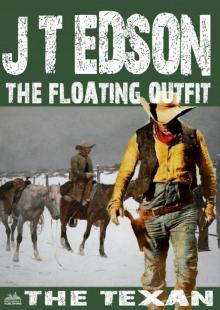 The Floating Outfit 46
The Floating Outfit 46 Dusty Fog's Civil War 11
Dusty Fog's Civil War 11 The Floating Outfit 61
The Floating Outfit 61 The Owlhoot
The Owlhoot Alvin Fog, Texas Ranger
Alvin Fog, Texas Ranger The Floating Outfit 34: To Arms! To Arms! In Dixie! (A Floating Outfit Western)
The Floating Outfit 34: To Arms! To Arms! In Dixie! (A Floating Outfit Western) The Floating Outfit 44
The Floating Outfit 44 Dusty Fog's Civil War 10
Dusty Fog's Civil War 10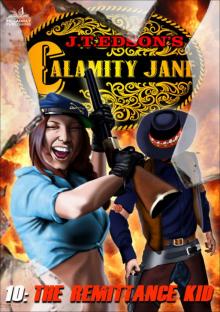 Calamity Jane 10
Calamity Jane 10 Cap Fog 4
Cap Fog 4 The Floating Outfit 51
The Floating Outfit 51 The Floating Outfit 50
The Floating Outfit 50 The Floating Outfit 49
The Floating Outfit 49 The Floating Outfit 10
The Floating Outfit 10 Apache Rampage
Apache Rampage The Floating Outfit 15
The Floating Outfit 15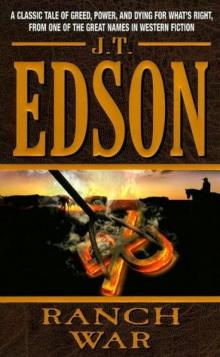 Ranch War
Ranch War The Floating Outfit 11
The Floating Outfit 11 The Devil Gun
The Devil Gun Sacrifice for the Quagga God (A Bunduki Jungle Adventure Book 3)
Sacrifice for the Quagga God (A Bunduki Jungle Adventure Book 3) Comanche (A J.T. Edson Western Book 1)
Comanche (A J.T. Edson Western Book 1) The Floating Outfit 48
The Floating Outfit 48 Wacos Debt
Wacos Debt The Rebel Spy
The Rebel Spy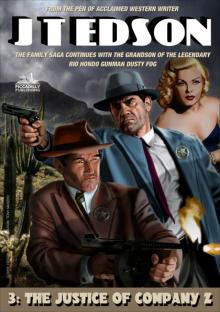 Cap Fog 3
Cap Fog 3 Trouble Trail
Trouble Trail Cold Deck, Hot Lead
Cold Deck, Hot Lead Rockabye County 4
Rockabye County 4 The Bullwhip Breed
The Bullwhip Breed Set Texas Back On Her Feet (A Floating Outfit Western Book 6)
Set Texas Back On Her Feet (A Floating Outfit Western Book 6)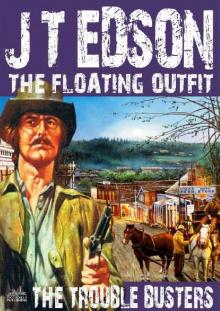 The Floating Outfit 25: The Trouble Busters (A Floating Outfit Western)
The Floating Outfit 25: The Trouble Busters (A Floating Outfit Western) Fearless Master of the Jungle (A Bunduki Jungle Adventure
Fearless Master of the Jungle (A Bunduki Jungle Adventure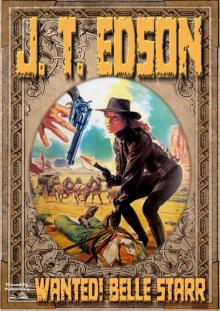 Wanted! Belle Starr!
Wanted! Belle Starr! The Big Hunt
The Big Hunt Running Irons
Running Irons The Floating Outfit 19
The Floating Outfit 19 You're in Command Now, Mr Fog
You're in Command Now, Mr Fog The Floating Outfit 27
The Floating Outfit 27 Texas Killers
Texas Killers Ole Devil and the Mule Train (An Ole Devil Western Book 3)
Ole Devil and the Mule Train (An Ole Devil Western Book 3) Bunduki and Dawn (A Bunduki Jungle Adventure Book 2)
Bunduki and Dawn (A Bunduki Jungle Adventure Book 2) The Fortune Hunters
The Fortune Hunters The Floating Outfit 12
The Floating Outfit 12 The Hide and Tallow Men (A Floating Outfit Western. Book 7)
The Hide and Tallow Men (A Floating Outfit Western. Book 7) Young Ole Devil
Young Ole Devil Slip Gun
Slip Gun The Drifter
The Drifter The Floating Outfit 45
The Floating Outfit 45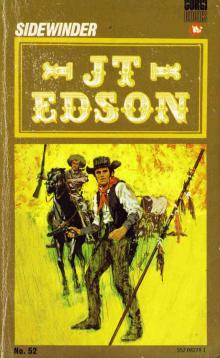 Sidewinder
Sidewinder The Ysabel Kid
The Ysabel Kid Waco 6
Waco 6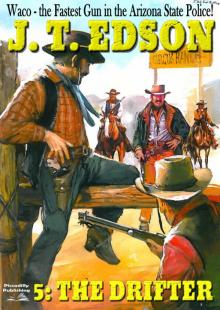 Waco 5
Waco 5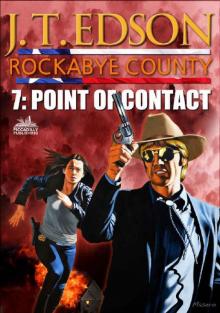 Point of Contact
Point of Contact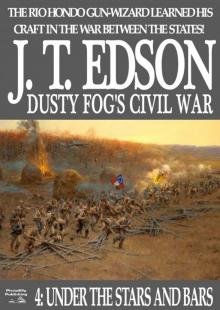 Under the Stars and Bars (A Dusty Fog Civil War Western Book 4)
Under the Stars and Bars (A Dusty Fog Civil War Western Book 4) The Floating Outfit 9
The Floating Outfit 9 Under the Stars and Bars
Under the Stars and Bars .44 Caliber Man
.44 Caliber Man The Floating Outfit 17
The Floating Outfit 17 Ole Devil at San Jacinto (Old Devil Hardin Western Book 4)
Ole Devil at San Jacinto (Old Devil Hardin Western Book 4) The Bloody Border
The Bloody Border A Horse Called Mogollon (Floating Outfit Book 3)
A Horse Called Mogollon (Floating Outfit Book 3) Waco 3
Waco 3 The Texan
The Texan The Floating Outfit 35
The Floating Outfit 35 Mississippi Raider
Mississippi Raider The Big Gun (Dusty Fog's Civil War Book 3)
The Big Gun (Dusty Fog's Civil War Book 3) Goodnight's Dream (A Floating Outfit Western Book 4)
Goodnight's Dream (A Floating Outfit Western Book 4) Waco 4
Waco 4 From Hide and Horn (A Floating Outfit Book Number 5)
From Hide and Horn (A Floating Outfit Book Number 5) The Floating Outfit 18
The Floating Outfit 18 Slaughter's Way (A J.T. Edson Western)
Slaughter's Way (A J.T. Edson Western) Dusty Fog's Civil War 7
Dusty Fog's Civil War 7 Two Miles to the Border (A J.T. Edson Western)
Two Miles to the Border (A J.T. Edson Western)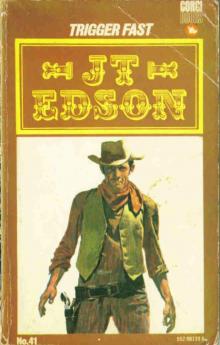 Trigger Fast
Trigger Fast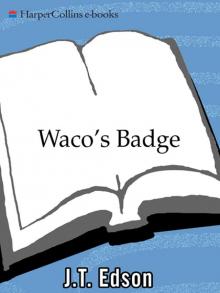 Waco's Badge
Waco's Badge A Matter of Honor (Dusty Fog Civil War Book 6)
A Matter of Honor (Dusty Fog Civil War Book 6) The Half Breed
The Half Breed Bunduki (Bunduki Series Book One)
Bunduki (Bunduki Series Book One) Kill Dusty Fog
Kill Dusty Fog Get Urrea! (An Ole Devil Hardin Western Book 5)
Get Urrea! (An Ole Devil Hardin Western Book 5) Dusty Fog's Civil War 9
Dusty Fog's Civil War 9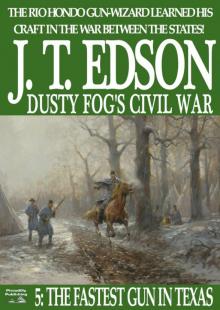 The Fastest Gun in Texas (A Dusty Fog Civil War Book 5)
The Fastest Gun in Texas (A Dusty Fog Civil War Book 5) Sagebrush Sleuth (A Waco Western #2)
Sagebrush Sleuth (A Waco Western #2) Quiet Town
Quiet Town Is-A-Man (A J.T. Edson Standalone Western)
Is-A-Man (A J.T. Edson Standalone Western) Rockabye County 5
Rockabye County 5 The Floating Outfit 14
The Floating Outfit 14 Cure the Texas Fever (A Waxahachie Smith Western--Book 3)
Cure the Texas Fever (A Waxahachie Smith Western--Book 3) The Floating Outfit 13
The Floating Outfit 13 The Road to Ratchet Creek
The Road to Ratchet Creek